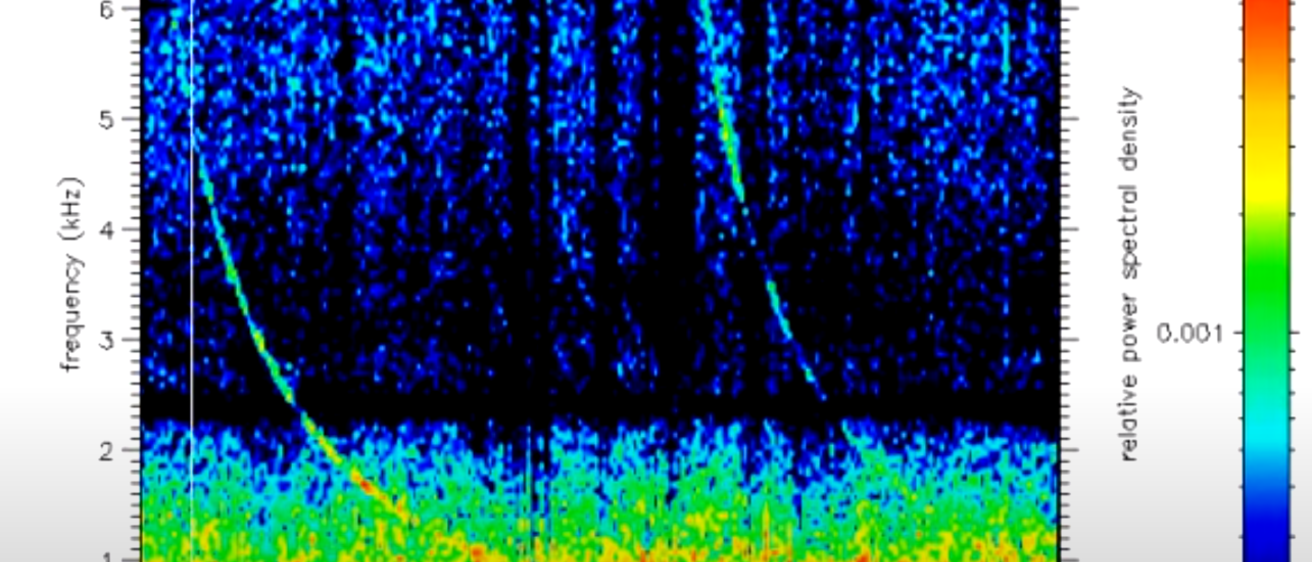In this AGU Eos article "The 21st Century’s “Music of the Spheres” about how data sonification is used to analyze and appreciate cosmic objects, Research Scientist/Engineer Bill Kurth describes how Voyager 1 recorded signals known as whistlers to detect lightning in the roiling clouds of Jupiter. The Cassini spacecraft, which orbited Saturn for 13 years, similarly revealed lightning in the ringed planet’s atmosphere.
In the "Lightning Crackles from Gas Giants" section of the article, it's noted that through a branch of sonification known as audification, scientists can perform a nearly one-to-one conversion of data to sounds.
Some conversions are as simple as audifying the “tick, tick, tick” of dust grains hitting a spacecraft, or recording the radio crackle of lightning in a planet’s atmosphere. Such recordings might need to be sped up a little to make the patterns more obvious, or pitched into the range of human hearing, but they’re realistic portrayals of the actual physical events.
Scientists at the University of Iowa, for example, have been audifying signals from solar system explorers since the Voyager missions of the 1980s. “Fred Scarf showed up at one of the Voyager press briefings with observations from the plasma wave experiment converted to sound,” said William Kurth, an Iowa research scientist who has participated in several missions. (Scarf is the original Principal Investigator for the Voyager PWS investigation) “The data were pretty esoteric, and [Scarf] was afraid the reporters’ eyes would gloss over just looking at these ‘wiggly line plots.’ But people would relate to these sounds. And everything was right in the audio frequency range, so he didn’t even have to change the pitch,” Kurth said.
Among many other findings, the Voyager instruments revealed lightning in the roiling clouds of Jupiter. Lightning bolts produce a wide range of electromagnetic energy, from visible light to radio waves. The energy propagates freely into space, where it can be detected by spacecraft. Voyager 1 recorded signals known as whistlers—low-frequency radio waves that are characteristic of lightning on Earth—but they were subtle and could have been produced by other phenomena.
“We wanted to be darn sure we knew what we were talking about before we claimed that we found lightning at Jupiter,” Kurth said. “So we listened to the sound. Based on years of experience listening to a lot of these things, those tones convinced us they really were lightning whistlers and not something else. It was another step in our verification.”
Years later, the Cassini spacecraft, which orbited Saturn for 13 years, similarly revealed lightning in the ringed planet’s atmosphere. “If you’ve ever been listening to an AM radio station while you’re driving at night, close to a thunderstorm, you hear a lot of crackling and popping,” said Kurth. “That’s radio emissions from the lightning strokes. And that’s what Cassini recorded from Saturn.”
Cassini also recorded dust strikes, which sounded like a hailstorm pounding an unlucky car.
Recordings from these missions have found life far beyond scientific circles. In the 1996 movie The Arrival, Charlie Sheen’s character discovers that aliens are about to invade Earth. “He puts together a bunch of satellite dishes to make a radio telescope, and hears a funny sound,” said Kurth. “He explains to a kid that it’s Voyager 2. And they used sounds it recorded at Uranus, which was a cute thing.”
Another instance of science serving as artistic inspiration is composer and musician Terry Riley’s Sun Rings. This performance by the Kronos Quartet and a 60-voice choir is based on Voyager’s “greatest hits” and premiered at the University of Iowa in 2002.
Sun Rings gained renewed interest during the pandemic, as one critic noted that “music of the spheres may be a concept as old as human imagination, and whistlers have been rudimentarily known about for some time, but it has taken a sanguine modern shaman of the string quartet to expose their musicality.”
